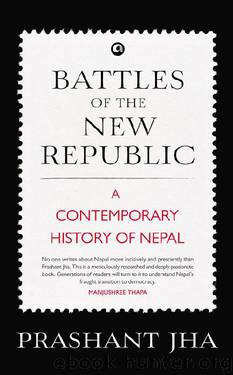BATTLES OF THE NEW REPUBLIC: A CONTEMPORARY HISTORY OF NEPAL by Prashant Jha

Author:Prashant Jha [Jha, Prashant]
Language: eng
Format: epub
Publisher: Aleph Book Company
Published: 2014-05-31T18:30:00+00:00
3
The major political struggle for thirty years between 1960 and 1990, when Mahendra and his son Birendra ran Nepal like a fiefdom, was to restore democracy.
NC leaders tried all possible modes of protest—courting arrest; waging non-violent campaigns; fighting from exile in India; resorting to violence, including hijacking an aircraft; and adopting a policy of reconciliation in the hope that this would pressure the king to become more accommodative. The Communist Party of Nepal splintered into different factions—some supported the monarchy for the sake of ‘nationalism’ (read resistance to India); others argued for an alliance with the NC for ‘democracy’. A radical fringe, inspired by the Naxalite revolt in West Bengal, experimented with a ‘revolutionary approach’, including class annihilation. Most of these battles were fought in the Tarai. The NC hijacked a plane from Biratnagar, and the ultra-Left started its revolution from the eastern Tarai district, Jhapa.
Madhesi leaders and activists were a part of this larger national battle. Many continued to support the NC, both because of their implicit belief in democracy and the faith that a free political system would empower the people of the plains. At a time when there was little hope that the monarchy could be defeated, they led lives of extraordinary struggle. The regime treated all dissenters harshly, but Madhesi democratic activists were particularly vulnerable. Many were imprisoned, some were killed, and many disappeared in mysterious circumstances.
Politics around Madhesi identity was limited, with scattered groups demanding federalism and autonomy. Raghunath Thakur was one such revolutionary Madhesi figure who identified key issues of discrimination against the Tarai and sought to mobilize opinion around it in the plains as well as in Delhi. His tract on the Tarai, Paratantra Madhes aur Uski Sanskriti, is still considered a bible by Madhesi activists. But his politics never gained momentum, and Thakur died in mysterious circumstances. Regional politics received a boost in the early 1980s when a former NC leader, Gajendra Narayan Singh, formed the Nepal Sadbhavana Parishad. The immediate trigger was a government commission report which recommended the sealing of the Indo-Nepal border, and suggested that the Madhesis were people of Indian origin, which outraged the Tarai leaders who insisted that while there may have been migration, many people had always lived on the same land for generations. The Sadbhavana demanded recognition of the Hindi language, citizenship for Tarai dwellers, federalism, and inclusion in state organs.
An alliance between the NC and various factions of the Left, and Indian support to the movement for democracy, finally led to the end of the Panchayat system in 1990.
The Sadbhavana turned into a political party, even though most Madhesi leaders continued in the bigger national parties like the NC and the newly formed Communist Party of Nepal (Unified Marxist Leninist) [UML]. But it struck a note of dissent on all major political events of the time. As a Constitution Drafting Committee comprising representatives of a few political parties and the king set out to write a democratic Constitution, Sadbhavana demanded elections to a CA.
Download
This site does not store any files on its server. We only index and link to content provided by other sites. Please contact the content providers to delete copyright contents if any and email us, we'll remove relevant links or contents immediately.
| Africa | Americas |
| Arctic & Antarctica | Asia |
| Australia & Oceania | Europe |
| Middle East | Russia |
| United States | World |
| Ancient Civilizations | Military |
| Historical Study & Educational Resources |
The Sympathizer by Viet Thanh Nguyen(4100)
The Rape of Nanking by Iris Chang(4028)
World without end by Ken Follett(3348)
Ants Among Elephants by Sujatha Gidla(3282)
Blood and Sand by Alex Von Tunzelmann(3062)
Japanese Design by Patricia J. Graham(3008)
City of Djinns: a year in Delhi by William Dalrymple(2438)
Foreign Devils on the Silk Road: The Search for the Lost Treasures of Central Asia by Peter Hopkirk(2393)
Inglorious Empire by Shashi Tharoor(2349)
The Queen of Nothing by Holly Black(2331)
India's Ancient Past by R.S. Sharma(2308)
In Order to Live: A North Korean Girl's Journey to Freedom by Yeonmi Park(2306)
Tokyo by Rob Goss(2295)
India's biggest cover-up by Dhar Anuj(2252)
Tokyo Geek's Guide: Manga, Anime, Gaming, Cosplay, Toys, Idols & More - The Ultimate Guide to Japan's Otaku Culture by Simone Gianni(2245)
The Great Game: On Secret Service in High Asia by Peter Hopkirk(2232)
Goodbye Madame Butterfly(2166)
Batik by Rudolf Smend(2011)
Living Silence in Burma by Christina Fink(1990)
